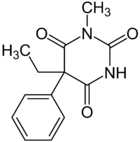- Methylphenobarbital
-
Methylphenobarbital 
Systematic (IUPAC) name 5-phenyl-5-ethyl-
3-methylbarbituric acidClinical data AHFS/Drugs.com International Drug Names MedlinePlus a605022 Pregnancy cat. ? Legal status Schedule IV (US) Routes ? Pharmacokinetic data Bioavailability ? Protein binding 70-76% Metabolism Hepatic Half-life 34 hours Excretion ? Identifiers CAS number 115-38-8 
ATC code N03AA01 PubChem CID 8271 DrugBank APRD00047 ChemSpider 7972 
UNII 5NC67NU76B 
KEGG D00700 
ChEBI CHEBI:6758 
ChEMBL CHEMBL45029 
Chemical data Formula C13H14N2O3 Mol. mass 246.3 SMILES eMolecules & PubChem  (what is this?) (verify)
(what is this?) (verify)Methylphenobarbital, also known as mephobarbital, (marketed in the US under the brand name Mebaral by Lundbeck) is a drug which is a barbiturate derivative.
Methylphenobarbital is used as a sedative, anxiolytic and anticonvulsant. It is the N-methylated analogue of phenobarbital, and has similar indications, therapeutic value, and tolerability.
Contents
Approval History
- 1935 Mebaral was introduced by Winthrop Pharmaceuticals.
- 2001 Methylphenobarbital discontinued in the UK.
- 2003 Mebaral acquired by Ovation Pharmaceuticals (a specialty pharmaceutical company that acquired underpromoted branded pharmaceutical products).
- 2009 Ovation was acquired by Lundbeck, which now markets Mebaral. However, Lundbeck recently announced that they are abandoning the product because, under the FDA unapproved-drug campaign, FDA is no longer willing to allow it to be grandfathered. A new drug application was never submitted to the FDA to gain marketing approval. The drug will no longer be available when supplies are depleted, which is anticipated by the end of 2011.
Overdose symptoms
Symptoms of overdose of mephobarbital include confusion, decrease in or loss of reflexes, somnolence, fever, irritability, hypothermia, poor judgment, shortness of breath or slow/troubled breathing, slow heartbeat, slurred speech, staggering, trouble in sleeping, unusual movements of the eyes, weakness
Chemistry
Mephobarbital (5-ethyl-1-methyl-5-phenylbarbituric acid) is synthesized according to one of the diagrams used for the phenobarbital synthesis, except one uses methylurea instead.
- W. Kropp, L. Taub, DE 537366 (1929).
References
- The Treatment of Epilepsy 2nd Ed by S. D. Shorvon (Editor), David R. Fish (Editor), Emilio Perucca (Editor), W. Edwin Dodson (Editor). Published by Blackwell 2004. ISBN 0-632-06046-8
Anticonvulsants (N03) GABAA receptor agonist Clobazam • Clonazepam • Clorazepate • Diazepam# • Flutoprazepam • Lorazepam • Midazolam • Nimetazepam • Nitrazepam • TemazepamOther GABA agents Carbonic anhydrase inhibitor Channel blockers Primarily sodiumPrimarily calciumUnknown/ungroupedChannel openers PotassiumRetigabineIndirect GABA agents GABA transaminase inhibitor: Valproic acid# (Sodium valproate & Valproate semisodium) • Valpromide • Valnoctamide • Valproate pivoxil
GABA reuptake inhibitor: TiagabineUnknown/multiple/
unsortedPropionates
This drug article relating to the nervous system is a stub. You can help Wikipedia by expanding it.
